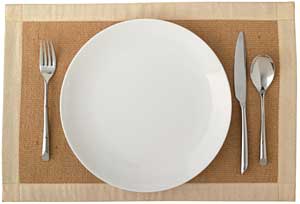More Health and Nutrition Bites
Related
How to choose the right portion size
In the last few decades portion size has become a major issue, with portions in restaurants increasing dramatically. Forty years ago a 32 ounce milk shake with 1,160 calories would have been unusual. There was no such thing as a Quarter Pounder (let alone a Double Quarter Pounder) and getting a mountain of nachos would be rare. These huge plates have spilled over into how people choose their food.
Portion Size
You read every day that there has been a dramatic increase in the size of portions. Everything from fast food to candy has been "supersized" in the last 30 years. The good news is that there are also a lot of great ingredients that have been produced with less fat and fewer calories. By using those foods and combining them with the right portion size it's easy to eat healthy.
Yes, portion sizes ARE getting bigger
Researchers at Chapel Hill, North Carolina sought to find out whether the conventional wisdom--that portion sizes have been getting bigger--is true or not (JAMA2003;289(4):450-453).
Health & Nutrition Bites
Get the latest health and diet news - along with what you can do about it - sent to your Inbox once a week. Get Dr. Gourmet's Health and Nutrition Bites sent to you via email. Sign up now!
Small Plates? Just a Myth

Just last month I reported on a study that concluded that children will eat more when presented with a larger amount of food (News Bite, 8/1/07). Another study seemed to show that using a larger bowl (or plate, presumably) would result in serving and eating more than if a regular-sized bowl is used (10/6/06). These studies seem to shore up the widely-held belief that using smaller plates will help you eat less. Scientists at Pennsylvania State University, however, designed a three-part study to evaluate this belief directly (Appetite 2007, doi:10.1016/j.appet.2007.04.005).
These three studies utilized three plates of identical appearance, but of different sizes: 17, 22, or 26 centimeters in diameter.
Part One: Participants ate lunch in the laboratory once a week for three weeks. On each occasion they were presented with an identical amount of food on a serving dish and were directed to serve themselves from the serving dish onto their plate prior to eating the meal. The same serving dish was used for each meal, but a different size plate (small, medium, or large) was used each time. The amount of food consumed by each participant was measured each time and analyzed, comparing amount eaten to the size of the plate.
Part Two: Participants ate lunch in the laboratory once a week for two weeks. Each time the same amount of food was served, but the difference this time was on the size of plate the meal was presented on (medium or large, in this case). Again the amount of food the participants ate was measured, then the researchers compared how much was eaten by each subject on which size plate.
Part Three: In this last arm of the study, once a week for three weeks the participants were given the smallest plate and given access to their own private buffet consisting of five popular foods containing the same number of calories by weight. Participant were directed to serve themselves from the buffet several feet away, then return to their place setting to sit down to eat. Once again the amount of food consumed was measured along with the number of trips made to the buffet.
The results? All three of the studies showed that the size of the plate (or needing to walk across the room) made no significant difference to the amount of food the subjects ate.
What this means for you
This study shows that you can't fool yourself into eating less by using smaller plates, and it does conflict with some other research on this subject. This is, however, one of the best designed studies I have seen on this topic and supports the idea that portion control is still an important tool for managing your weight. Here are some portion size guidelines to help you know what is a standard portion size.
First posted: September 5, 2007
